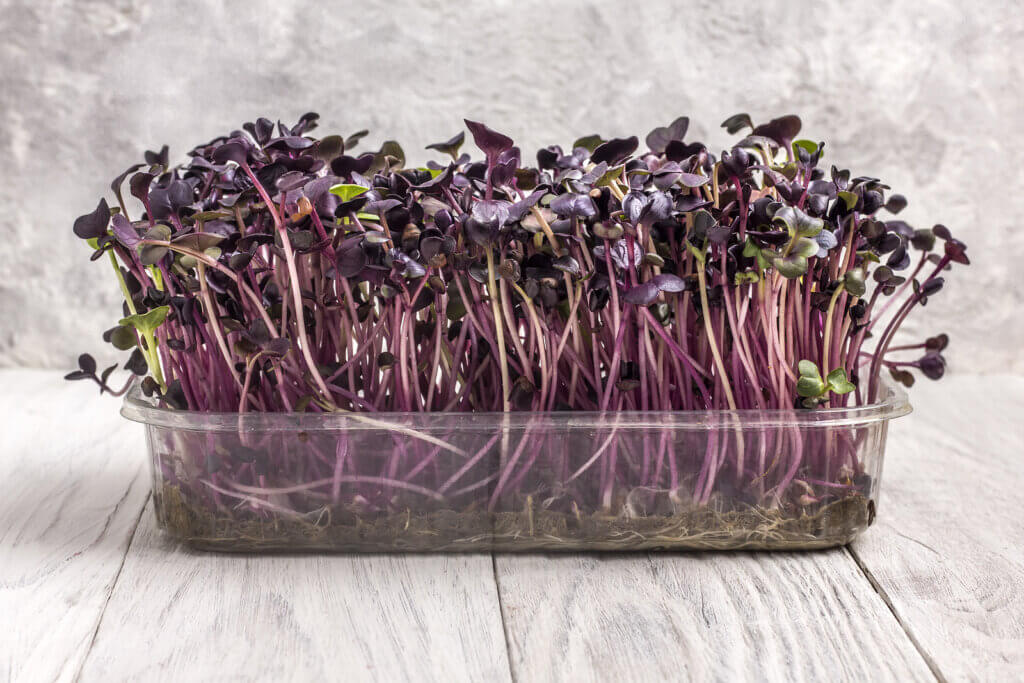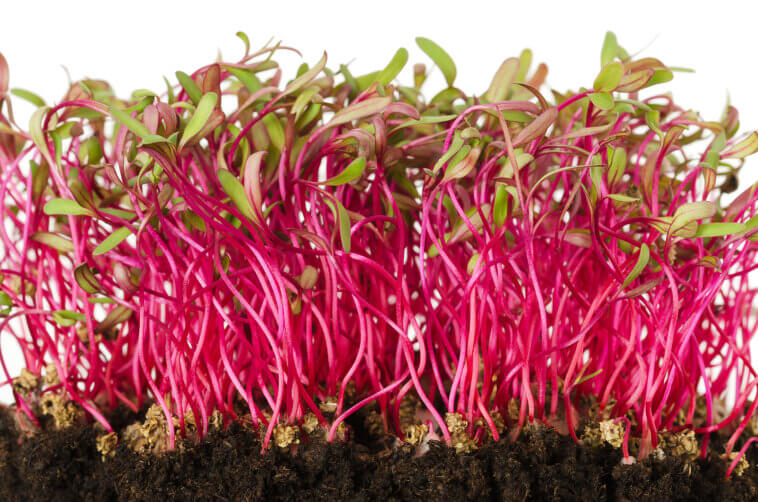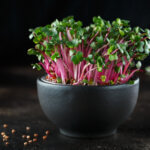Table of Contents
Over the past few years, I've been absolutely fascinated by the culinary trend that's taken the world by storm – microgreens. These little bursts of vibrant color not only catch your eye but also come loaded with an incredible nutritional punch. Among the diverse array of microgreens, there's one variety that has always intrigued me – red microgreens.
These tiny red wonders are not just a treat for the eyes but also offer a wide range of health benefits. Join me on this exciting journey as we dive deep into the world of red microgreens, uncovering their origins, discovering their impressive nutritional value, exploring how to cultivate them, and uncovering the delightful ways they can be used in the kitchen.
Understanding Red Microgreens
What are Red Microgreens?
Red microgreens, sometimes referred to as red sprouts or red shoot greens, are a fascinating category of tiny greens celebrated for their striking red or purple hue. These diminutive greens are plucked from the soil at a very early stage of development, usually right after the emergence of their first true leaves. It's important to note that red microgreens do not represent a distinct plant variety; instead, they constitute the fledgling seedlings of various vegetables and herbs, including radishes, beets, amaranth, and basil.
One of the most alluring aspects of red microgreens lies in their intense flavor profile, which packs a punch that belies their diminutive size. This robust taste is what has endeared them to both professional chefs and health-conscious individuals alike.
The visual appeal of these microgreens, with their vivid red or purple coloration, adds an extra layer of excitement to culinary creations and makes them a popular choice for garnishes, salads, and artistic plating in gourmet dishes.
Red microgreens are not only a feast for the eyes but also a nutritional powerhouse, often boasting a higher concentration of vitamins, minerals, and antioxidants compared to their mature counterparts. Incorporating red microgreens into your diet can be a flavorful and healthful way to elevate your culinary endeavors red arrow radish microgreens.
Origin and History
Originating in Asia, red microgreens boast a rich history intertwined with diverse culinary traditions spanning centuries. These miniature marvels have left their indelible mark on the culinary landscape, primarily for their ability to infuse dishes with both vibrant color and intense flavor. While their historical use in Asian cuisines is well-documented, it's essential to highlight that their journey to widespread Western recognition is a more recent phenomenon.
Red microgreens, with their captivating red or purple hues and robust taste, gradually found their way into the Western culinary scene in recent years. Their ascent to prominence in Western cuisine can be attributed to the growing interest in fresh, locally sourced, and visually appealing ingredients. As a result, these diminutive greens are now readily available not only in upscale gourmet restaurants but also in the vibrant stalls of farmers' markets and the kitchens of enthusiastic home cooks.
The resurgence of interest in red microgreens can be partly attributed to their versatility in enhancing the aesthetics and flavors of a wide range of dishes. Their adoption in Western culinary circles is a testament to the ever-evolving nature of gastronomy and the constant quest for innovative ingredients to elevate culinary experiences.
Today, red microgreens have firmly established themselves as an exciting culinary trend, enriching both traditional and contemporary dishes with their distinctive charm red rambo radish microgreens.

A Nutrient-Packed Powerhouse
Red microgreens, also known as red sprouts or red shoot greens, are celebrated not just for their visual appeal but also for their exceptional nutritional profile, making them a true dietary powerhouse. These tiny greens offer a host of vital nutrients that can significantly enhance the nutritional content of your meals. Let's explore in greater detail the wealth of essential nutrients that red microgreens have to offer:
Vitamins
Red microgreens are a veritable treasure trove of vitamins, providing an array of essential micronutrients that are essential for overall health. Among the vitamins they contain, vitamin A takes center stage. Red microgreens are particularly abundant in this nutrient, and it plays a pivotal role in maintaining healthy vision, promoting vibrant skin, and bolstering the immune system. Additionally, these greens boast substantial amounts of vitamin C, known for its immune-boosting properties, as well as vitamin K, which is crucial for proper blood clotting and bone health. The presence of various B vitamins further contributes to the overall nutritional value of red microgreens.
Minerals
Red microgreens are not only rich in vitamins but also serve as a reliable source of essential minerals. Within these diminutive leaves, you'll find significant amounts of calcium, vital for the development of strong bones and teeth. Iron, another essential mineral, is abundant in red microgreens and plays a pivotal role in oxygen transport throughout the body. Magnesium and potassium, two other minerals present in these greens, are important for maintaining proper muscle and nerve function, as well as regulating blood pressure.
Antioxidants
Red microgreens are teeming with antioxidants, which are powerful compounds that help neutralize harmful free radicals in the body. These antioxidants include beta-carotene, known for its role in eye health, anthocyanins, which give red microgreens their vibrant color and have been linked to various health benefits, and quercetin, a potent anti-inflammatory agent. Consuming foods rich in antioxidants, such as red microgreens, can help reduce the risk of chronic diseases and support overall well-being.
Dietary Fiber
Despite their small size, red microgreens also contain dietary fiber. Fiber is an essential component of a healthy diet, aiding in regular bowel movements, promoting a feeling of fullness, and contributing to overall gastrointestinal health. Incorporating red microgreens into your meals can help you meet your daily fiber needs while adding a burst of vibrant color and intense flavor to your dishes.
Red Microgreens Health Benefits
Embracing a diet enriched with red microgreens can lead to a spectrum of compelling health benefits. These vibrant miniature greens are more than just a culinary delight; they pack a nutritional punch that can significantly contribute to your overall well-being. Let's delve into the extensive array of health advantages that regularly consuming red microgreens can offer:
Enhanced Immune Function
One of the standout benefits of red microgreens lies in their robust vitamin C content. Vitamin C is a potent immune booster that plays a pivotal role in strengthening your body's defenses against infections and illnesses. Regular consumption of red microgreens can fortify your immune system, helping you ward off common ailments.
Heart Health
Red microgreens come equipped with a two-fold approach to promoting cardiovascular well-being. Firstly, they contain potassium, a mineral renowned for its ability to regulate blood pressure. Maintaining healthy blood pressure levels is vital in reducing the risk of heart diseases. Secondly, the abundant antioxidants found in red microgreens contribute to heart health by reducing oxidative stress and inflammation, both of which are key factors in cardiovascular health.
Cancer Prevention
The antioxidant-rich nature of red microgreens is a potent weapon in the battle against cancer. These antioxidants, including beta-carotene, anthocyanins, and quercetin, work tirelessly to neutralize harmful free radicals in the body. By doing so, they help to mitigate cellular damage and reduce the risk of developing cancer, making red microgreens a valuable addition to your cancer prevention strategy.
Eye Health
Vitamin A is another standout nutrient found in red microgreens, and it plays a pivotal role in maintaining optimal vision. Ensuring an adequate intake of vitamin A through foods like red microgreens can contribute to good eye health and may help prevent age-related eye conditions, such as macular degeneration and cataracts.
Read also our post on Tips for Cucumber Microgreens
Growing Red Microgreens
Cultivation at Home
Embarking on the journey of cultivating red microgreens at home is not only rewarding but also an economically sound way to ensure a fresh and continuous supply of these nutritious greens. Here's an in-depth, step-by-step guide to help you successfully grow red microgreens indoors:
- Select Your Seeds: Begin by choosing high-quality red microgreen seeds from a reputable source. Popular varieties include red radish, red amaranth, and red basil. The selection of quality seeds is a fundamental step in ensuring a successful harvest.
- Prepare Your Growing Medium: Opt for a sterile and soilless growing medium, such as coconut coir or peat moss. Fill a shallow tray or container with the chosen growing medium, leaving approximately an inch of space at the top. This will provide ample space for the seeds to germinate and grow.
- Sow the Seeds: Evenly sprinkle the red microgreen seeds across the surface of the growing medium. You can plant them densely, as red microgreens do not require significant spacing, as they won't reach full maturity. Gently press the seeds into the growing medium to ensure good seed-to-soil contact.
- Watering: Carefully mist the seeds with water until the surface is adequately moistened. To maintain optimal growth conditions, cover the tray with a clear lid or plastic wrap. This cover helps create a humid microenvironment, which is conducive to germination and early growth. Ensure that the soil remains consistently moist but not waterlogged throughout the growth cycle.
- Lighting: Place the tray in a well-lit area, preferably near a window with indirect sunlight. If natural light is limited, consider using grow lights to provide consistent and adequate illumination. Adequate lighting is crucial for robust and healthy growth.
- Harvesting: Red microgreens are typically ready for harvest within 7 to 14 days after germination, depending on the variety and growing conditions. To harvest, use a pair of scissors and cut the microgreens just above the soil level. This method allows you to gather a fresh supply of red microgreens while leaving the remaining plants to continue growing for subsequent harvests.
Commercial Cultivation
Delving into the realm of commercial cultivation for red microgreens entails a comprehensive approach aimed at producing substantial quantities of these vibrant and nutritious greens. Commercial growers employ sophisticated methods, such as hydroponic or soil-based systems, to scale up production while ensuring consistent quality. Here's an insightful look into the key aspects of commercial red microgreen cultivation:
- Scaling Up Production: Unlike home cultivation, commercial growers are focused on producing large quantities of red microgreens to meet market demands. To achieve this, they often operate in spacious, dedicated growing facilities designed to accommodate numerous trays or systems for simultaneous cultivation.
- Hydroponic or Soil-Based Systems: Commercial cultivation offers the flexibility to choose between hydroponic and soil-based systems, depending on the specific needs and preferences of the grower. Hydroponic systems involve growing microgreens in nutrient-rich water solutions, while soil-based systems use traditional growing media like soil or peat. The choice of system can impact factors such as resource efficiency, crop cycle time, and overall yield.
- Environmental Control: Commercial growers place great emphasis on maintaining optimal environmental conditions to ensure consistent and high-quality yields. This includes precise control of temperature, humidity, and lighting. By carefully regulating these factors, growers can create an ideal microenvironment that promotes rapid and healthy growth throughout the year.
- Pest and Disease Management: In commercial cultivation, vigilant pest and disease management are paramount. Integrated pest management (IPM) strategies are often employed to minimize the use of pesticides and maintain the health of the crop. This may involve regular monitoring, the introduction of beneficial insects, and implementing sanitation practices to prevent outbreaks.
- Crop Rotation and Succession Planting: To maximize efficiency and yield, commercial growers typically practice crop rotation and succession planting. This involves carefully planning the cultivation schedule to ensure a constant supply of fresh red microgreens. It also helps prevent soil depletion and reduce the risk of disease buildup.
- Harvesting and Packaging: Commercial growers employ efficient harvesting techniques to gather red microgreens at the peak of freshness. Once harvested, the greens are often carefully packaged to maintain their quality during storage and transportation to market outlets.
- Market Considerations: Commercial growers must also consider market demands, including packaging preferences and distribution channels. Whether supplying to restaurants, retailers, or direct-to-consumer markets, understanding customer preferences and meeting quality standards is crucial for success.
Read also our post on Cantaloupe Microgreens Seeds
Culinary Uses of Red Microgreens
Exploring the culinary world of red microgreens reveals their versatility as an ingredient, capable of enhancing both the flavor and visual appeal of a wide array of dishes. Here's an expanded list of creative culinary uses that demonstrate the full potential of red microgreens:
Salads
Red microgreens are a salad enthusiast's delight. Sprinkle them generously over your leafy greens or grain-based salads to infuse vibrant hues and introduce a delightful, peppery, and earthy flavor. Their petite size and intense color make them an eye-catching addition to any salad composition.
Garnishes
Elevate your culinary creations to a new level of sophistication by using red microgreens as garnishes. Whether it's a bowl of soup, a sandwich, a platter of appetizers, or even a gourmet entree, these diminutive greens provide an elegant touch and a subtle crunch. They not only elevate the aesthetic appeal but also enhance the overall taste profile of your dishes.
Smoothie
Red microgreens are not limited to savory dishes; they can also shine in your morning smoothie. Incorporating these greens into your favorite smoothie recipes provides an extra nutrient boost. Their vibrant color and earthy notes can complement the sweetness of fruits, creating a balanced and visually appealing blend.
Stir-Fries
Transform your stir-fries into visually stunning and nutritionally dense creations by tossing in red microgreens at the last minute. Their pop of color and freshness not only enhances the visual appeal of the dish but also introduces a layer of complexity to the flavors.
Sandwiches and Wraps
Red microgreens are excellent additions to sandwiches and wraps, where they contribute both flavor and nutrition. Their subtle spiciness pairs well with a variety of fillings, and their tender texture adds a delightful contrast to the overall mouthfeel of the sandwich or wrap. Whether in a classic BLT, a veggie wrap, or a gourmet panini, red microgreens can elevate your sandwich game.
Pasta Dishes
Sprinkle a handful of red microgreens over your pasta dishes, such as spaghetti or fettuccine, just before serving. Their peppery kick and vibrant color make them a delightful finishing touch that enhances both taste and presentation.
Sushi and Sashimi
Red microgreens can be used to garnish sushi rolls and sashimi platters. Their fresh and peppery flavor complements the delicate taste of seafood, while their vivid color adds an enticing visual contrast to the dish.
Conclusion
My journey through the world of red microgreens has been a delightful exploration that's enriched my culinary experiences in more ways than one. These tiny, vibrant greens have not only added a burst of color to my plates but have also introduced a new dimension of flavor and nutrition to my meals. From their origins in Asian culinary traditions to their recent rise in Western gastronomy, red microgreens have captured my imagination, reminding me of the ever-evolving nature of food and the joy of discovering new ingredients.
Cultivating red microgreens at home has been a rewarding endeavor, offering me a fresh and continuous supply of these nutritious greens. On the commercial front, I've gained an appreciation for the dedication and precision of professional growers in ensuring both quality and quantity.
And in my own kitchen, I've embraced the versatility of red microgreens, using them to elevate everything from salads to sushi. Red microgreens have become more than just an ingredient; they've become a cherished part of my culinary journey, reminding me that even the smallest additions can make a profound impact on the flavors and aesthetics of a dish.
Sources
https://agresearchmag.ars.usda.gov/2017/jun/microgreen/
https://spac.umd.edu/news/story/umd-researchers-find-microgreens-to-have-high-levels-of-nutrients
https://www.sciencedirect.com/science/article/pii/S2772566921000057




Comments
Loading…